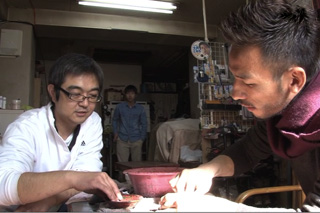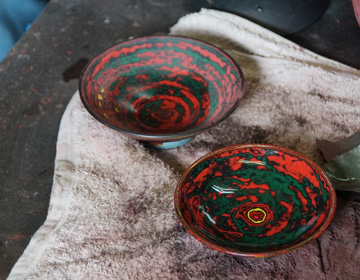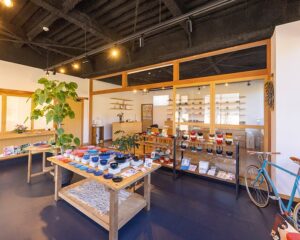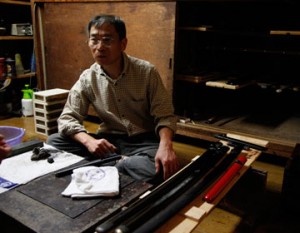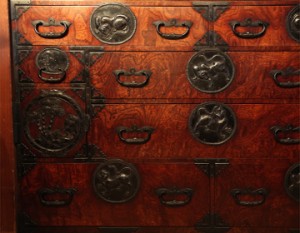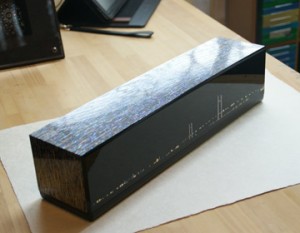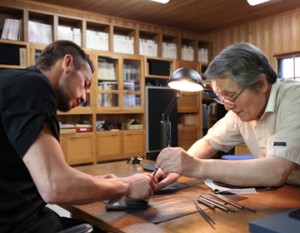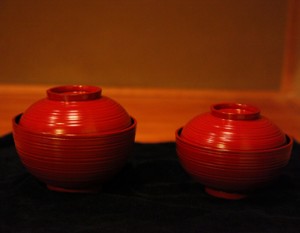What is Sendai “tsuishu”?
”Tsuishu” is a form of Japanese lacquer craft, but it is different from the standard form where lacquer is painted and polished on wood. ”Tsuishu” is made by painting dozens to hundreds of layers of red lacquer, creating a base of multiple layers of lacquer, which is then carved and polished. In other words, it is a form of engraving the many many layers of lacquer. This technique called ”chousitu” came from China between the Kamakura period and Muromachi period.
However, Sendai ”tsuishu” is a little different from ”chousitu”. Sendai tsuishu is made by engraving the base wood then painting red lacquer over the engraving and polishing it. Painting lacquer on the engraved wood requires very delicate technique, especially when painting the very fine lines.
”Painting is hard work, but the polishing is more so.” said Kazunori Minami , Sendai tsuishu artist.
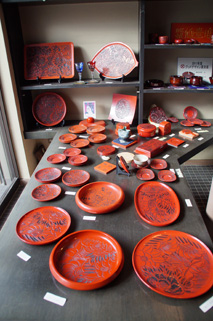
The things an ordinary craftsman wouldn’t do.
Minami is the only Sendai tsuishu remaining. He carries on the tradition but at the same time, he takes on new challenges and new designs, and he won the Good Design Award 2011.
As we were shown around the workshop, what impressed us was a vessel with a maple leaf tree engraving. It was a transparent vessel made from layers of lacquer, and the leaf looked as if it were floating.
”I don’t think anyone else would make such a thing.” said Minami.
This technique called ”tsuitou” requires days and days of work to achieve the necessary thickness by painting layer after layer of lacquer. It is something that ”you must be crazy to do”. Nakata was very surprised to hear that.
And there were more surprises. ”You know, lacquer ware can become soft and disfigured.” We couldn’t quite grasp his meaning, but then he brought a bucket of hot water, and put the maple leaf vessel in it. After a while, he took it out, and indeed, it was soft and disfigured.
”But after a while, when it is dry, it resumes its original shape. Shape memory.”
Since we think of lacquer to be a hard material once it is dried, its beyond the imagination. ”Even among people who work with lacquer, this characteristic may not be known.” said Minami. Having an inquisitive mind is probably one of the factors adding a fresh twist to the tradition.
♦Photo bottom right: provided by the Department of Protection of Cultural Properties, Miyagi Prefecture
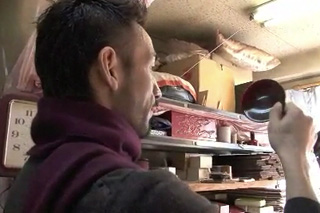

Polishing brings out the many colors
Sendai tsuishu is painting lacquer on a base that is intricately engraved, so it is very delicate work. It then has to be ground and polished. ”The polishing part is the hardest.” said Minami.
We were invited to give it a try in his workshop. Nakata experienced polishing with sandpaper. Lacquer of many different colors are painted layers upon layers, and when polished with sandpaper, green, yellow, blue and other colors appeared. In some spots, it appeared in gradation. In others, a totally different color appeared. Nakata became so engrossed with the work that he lost all track of time. Minami told us that he sometimes visits elementary and junior high schools to give students a try, and they too become fully engrossed.
Inheriting tradition, but not bound by tradition. This is how Minami, the only remaining Sendai tsuishu artist, continues to create something new every day.
